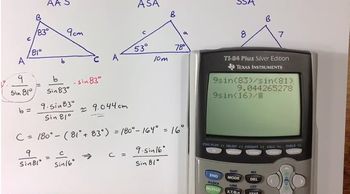Table of contents
- 0. Review of College Algebra4h 43m
- 1. Measuring Angles39m
- 2. Trigonometric Functions on Right Triangles2h 5m
- 3. Unit Circle1h 19m
- 4. Graphing Trigonometric Functions1h 19m
- 5. Inverse Trigonometric Functions and Basic Trigonometric Equations1h 41m
- 6. Trigonometric Identities and More Equations2h 34m
- 7. Non-Right Triangles1h 38m
- 8. Vectors2h 25m
- 9. Polar Equations2h 5m
- 10. Parametric Equations1h 6m
- 11. Graphing Complex Numbers1h 7m
7. Non-Right Triangles
Law of Sines
Problem 7
Textbook Question
In Exercises 1–12, solve each triangle. Round lengths to the nearest tenth and angle measures to the nearest degree. If no triangle exists, state 'no triangle.' If two triangles exist, solve each triangle. C = 50°, a = 3, c = 1
 Verified step by step guidance
Verified step by step guidance1
Step 1: Use the Law of Sines to find angle A. The Law of Sines states that \( \frac{a}{\sin A} = \frac{c}{\sin C} \). Substitute the known values: \( \frac{3}{\sin A} = \frac{1}{\sin 50^\circ} \).
Step 2: Solve for \( \sin A \) by rearranging the equation: \( \sin A = \frac{3 \cdot \sin 50^\circ}{1} \). Calculate \( \sin A \) using the sine of 50 degrees.
Step 3: Determine if \( \sin A \) is a valid sine value (i.e., between -1 and 1). If \( \sin A > 1 \), then no triangle exists. If \( \sin A \leq 1 \), proceed to find angle A using \( A = \sin^{-1}(\sin A) \).
Step 4: Calculate angle B using the angle sum property of triangles: \( B = 180^\circ - A - C \).
Step 5: Use the Law of Sines again to find side b: \( \frac{b}{\sin B} = \frac{a}{\sin A} \). Rearrange to solve for b: \( b = \frac{a \cdot \sin B}{\sin A} \).
Recommended similar problem, with video answer:
 Verified Solution
Verified SolutionThis video solution was recommended by our tutors as helpful for the problem above
Video duration:
3mPlay a video:
Was this helpful?
Key Concepts
Here are the essential concepts you must grasp in order to answer the question correctly.
Law of Sines
The Law of Sines is a fundamental principle in trigonometry that relates the ratios of the lengths of sides of a triangle to the sines of its angles. It states that for any triangle with sides a, b, and c opposite angles A, B, and C respectively, the ratio a/sin(A) = b/sin(B) = c/sin(C) holds true. This law is particularly useful for solving triangles when given two angles and one side or two sides and a non-included angle.
Recommended video:

Intro to Law of Sines
Ambiguous Case of the Law of Sines
The ambiguous case occurs when using the Law of Sines to solve for a triangle with two sides and a non-included angle (SSA condition). In this scenario, there can be zero, one, or two possible triangles depending on the given measurements. Understanding this concept is crucial for determining whether a triangle can be formed and how many solutions exist.
Recommended video:

Solving SSA Triangles ("Ambiguous" Case)
Triangle Existence Criteria
Triangle existence criteria dictate the conditions under which a triangle can be formed from given side lengths and angles. For example, the sum of the angles in a triangle must equal 180 degrees, and the lengths of any two sides must be greater than the length of the third side. These criteria help in identifying whether a triangle can exist based on the provided dimensions.
Recommended video:

30-60-90 Triangles

 4:27m
4:27mWatch next
Master Intro to Law of Sines with a bite sized video explanation from Patrick Ford
Start learningRelated Videos
Related Practice
















